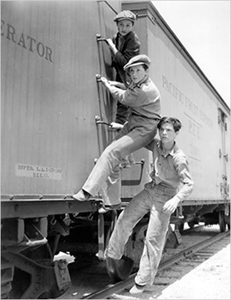Film has explored the plight of homeless children since its beginnings. And a few show these children constructing and reconstructing ecology into something more like a home. A Lumiere view from 1896 shows Indochina youth chasing coins and rice thrown by their white colonizers. Charlie Chaplin’s tramp character adopts a homeless boy in The Kid (1921). But in Wild Boys of the Road(1933), two boys leave home during the Depression to relieve their parents’ economic woes. In Wild Boys, Eddie (Frankie Darro) and Tommy (Edwin Phillips) join Sally (Dorothy Coonan) and a group of boys and girls hopping trains and looking for work and community in both rural and urban settings. One scene in particular highlights their ability to adapt to their tragic environment, reconstructing a “Sewer City” into viable homes.
After WWII, films of various genres include homeless characters searching for and sometimes adapting their environment into homes. A B-Western, Song of Arizona (1946) centers on preserving a ranch for wayward boys. The second segment of Rosselini’s war drama Paisan(1946), which is set in Naples, ends with a military police officer taking a young thief home to a community living in caves under the most primitive conditions. The historical drama Border Street (1948) highlights the trauma that orphaned children suffered in the Warsaw Ghetto by contrasting their tragic environment with that of deluded Hitler Youth. In the comic fantasy Miracle in Milan (1951), orphaned homeless teenager Toto (Francesco Golisano) builds a communal shantytown for hoboes with the help of a magic dove. A homeless child even appears in the comic The Betty Hutton Show in 1959.
The stories of homeless children grow more tragic in fictional films from the 1980s. Hector Babenco’s crime drama, Pixote (1981) highlights the devolution of a ten-year-old boy Pixote (Fernando Ramos da Silva) after police arrest him for vagrancy. Life in the detention center is deadly, but life on the street to which Pixote escapes is almost as hard. Another crime drama, Salaam Bombay (1988) and an animated film, Grave of the Fireflies (1988), illustrate the diversity of films about homeless children during this period, but also show how difficult it is to transform hellish environments into homes.
More recent features provide hopeful resolutions for homeless children adapting hostile environments into homes, especially when responsible adults intervene. In Walter Salles’s Oscar-nominated Central Station (1998), the orphaned Josué (Vinícius de Oliveira) spends only a few nights alone in a train station before Dora (Fernanda Montenegro) takes him in and eventually reunites him with his older brothers. Pursuit of Happyness (2006) provides a similar narrative of self-realization, with father Chris (Will Smith) caring for his son Christopher (Jaden Smith) in a subway bathroom only temporarily while he pedals his invention and interns with a brokerage firm. A Gentile Polish sewer worker hides Polish Jewish children in sewers during the German occupation in In Darkness (2011). All these films highlight the search for home and the drive toward more positive evolutionary narratives.


No comments:
Post a Comment